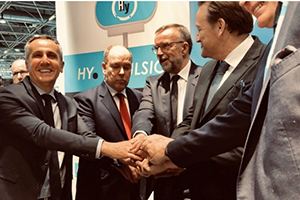The first stone of the Chambéry hydrogen station was laid on 24 June* after the joint investment of Banque des Territoires and the Auvergne-Rhône-Alpes Region, in Hympulsion with a 49% stake. The objective: to deploy France's largest renewable hydrogen mobility project, Zero Emission Valley (ZEV).
The Engie and Michelin Groups, and to a lesser degree Credit Agricole, hold the other 51% of the share capital. At the same time, ZEV has been chosen by the European Commission and will benefit from a €10.1mn European grant for a total budget of €50mn.
The company Hympulsion will therefore be able to step up the deployment of ZEV by simultaneously rolling out:
- a fleet of 1,000 fuel-cell vehicles,
- 20 hydrogen filling stations,
- 15 electrolysers to produce hydrogen from renewable electricity, without any CO2 emissions.
Sectors in which development is in full swing, such as hydrogen, need our assistance to realise their potential. We help to develop sectors which should have a bright future, but which require risks to be taken in the beginning.
Philippe Lambert, directeur régional Auvergne-Rhône-Alpes de la Banque des Territoires
ZEV addresses three issues - an environmental issue, an industrial issue and an economic issue:
- Transport based on renewable hydrogen will improve air quality across the 9 priority areas in the region;
- the region is home to close to 80% of stakeholders in the French hydrogen sector. The development of transport based on hydrogen will revitalise and help sustain this sector of excellency. The challenge is to produce large-scale hydrogen systems that meet low-carbon requirements and provide hydrogen vehicles at a similar user-cost to diesel;
- this project will create jobs in the Auvergne-Rhône-Alpes region, and will allow training centres within the region to guide youths towards future careers in clean mobility and the zero-carbon industry.
By replacing 4.3 million litres of diesel and avoiding 13,000 tons of CO2 over 15 years, this project will provide a response to climate issues, whilst proving that economic development, wealth creation and environmental protection are compatible.
How do hydrogen and fuel-cell vehicles work? Fuel-cells are an onboard means of producing the electricity required to power an electric motor. This fuel-cell runs on hydrogen which, when combined with the oxygen in the air, produces the necessary electricity for traction. The only emissions produced are water and steam. The result is zero pollutants, zero particles, zero CO2 and zero motor noise.
* For an official launch during the 4th quarter of 2019.


